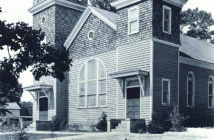One of the major beneficiaries of the Morse telegraph was the American railroad system. The telegraph made it possible to accurately track the position of trains by passing critical information between railroad stations. The Richmond-Petersburg Railroad had been previously dependent on lamps and other less reliable means could now be confirmed by railroad dispatchers.
A little known fact is that technically, Morse had developed the first system of truly digital communications, a concept which has only recently entered commercial use. His alphabetical, numerical and punctuation characters, represented by long and short electrical bursts, is not unlike the basis of the one and zero bits system employed in digital computers, digital TV and cell phones.
While early telegraph lines often ran alongside railroad tracks for general communications, as did the line along the Richmond-Petersburg Railroad, cut numerous times during the Civil War; it was not until 1851 that the telegraph was first used for train routing.
Contact Ray Potter at 716-9767 or [email protected] for information about the Richmond Railroad Museum.


